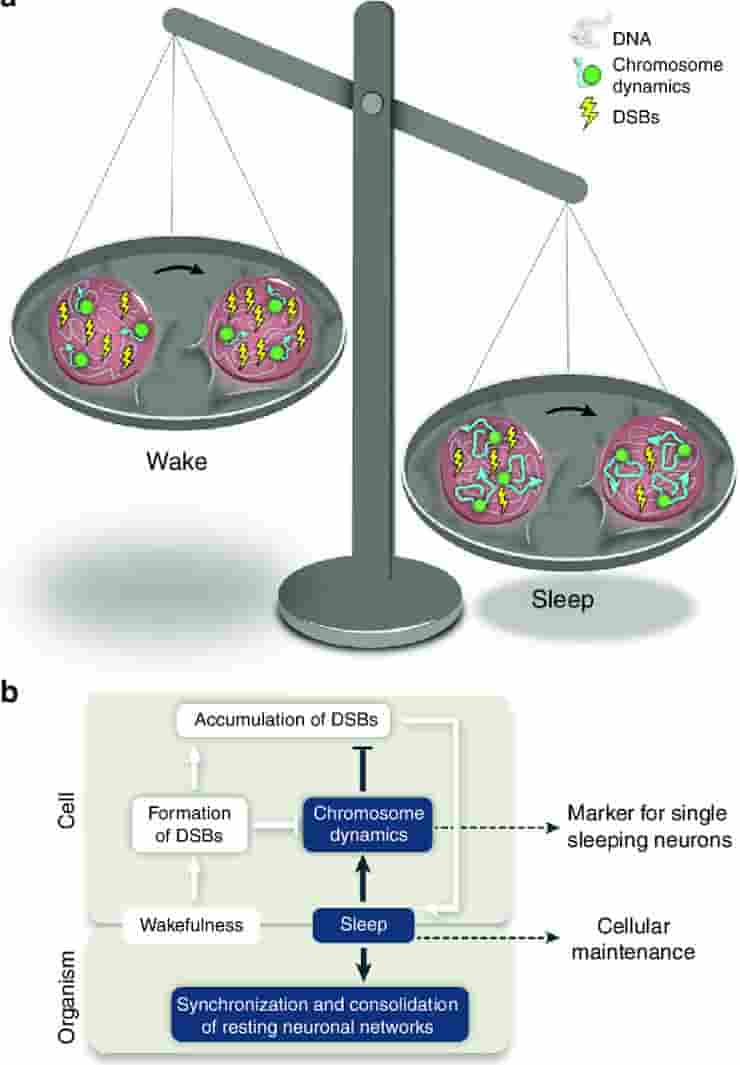Researchers at Bar-Ilan University in Israel report a novel and unexpected function of sleep that they believe could explain how sleep and sleep disturbances affect brain performance, aging and various brain disorders.
Using 3-D time-lapse imaging techniques in live zebrafish, the researchers were able to define sleep in single-chromosome resolution, and show for the first time that single neurons require sleep in order to perform nuclear maintenance.
Throughout evolution, sleep has remained universal and essential to all organisms with a nervous system, including invertebrates such as flies, worms, and even jellyfish. But the reason that animals sleep, even despite the continuous threat of predators, remains a mystery, and is considered among the most important unanswered questions in life sciences.
DNA damage can be caused by many processes including radiation, oxidative stress, and even neuronal activity. DNA repair systems within each cell correct this damage. The current work shows that during wakefulness, when chromosome dynamics are low, DNA damage consistently accumulates and can reach unsafe levels.
The Price Of Wakefulness
The role of sleep is to increase chromosome dynamics and normalize the levels of DNA damage in each single neuron. Apparently, this DNA maintenance process is not efficient enough during the online wakefulness period and requires an offline sleep period with reduced input to the brain in order to occur.
“It’s like potholes in the road. Roads accumulate wear and tear, especially during daytime rush hours, and it is most convenient and efficient to fix them at night, when there is light traffic,”
says Prof. Lior Appelbaum, of Bar-Ilan University’s Mina and Everard Goodman Faculty of Life Sciences and Gonda (Goldschmied) Multidisciplinary Brain Research Center, who led the study.
Appelbaum calls the accumulation of DNA damage the “price of wakefulness.” He and his doctoral student David Zada, first author of the study, as well as co-authors Dr. Tali Lerer-Goldshtein, Dr. Irina Bronshtein, and Prof. Yuval Garini, hypothesized that sleep consolidates and synchronizes nuclear maintenance within individual neurons, and set out to confirm this theory.
Zebrafish Chromosome Dynamics
Their discovery was achieved thanks to the characteristics of the zebrafish model. With their physical transparency and a brain very similar to humans, zebrafish are a perfect organism in which to study single cells within a live animal under physiological conditions.
Using a high-resolution microscope, the movement of DNA and nuclear proteins within the cell can be observed in vivo while the fish are awake and asleep. The researchers were particularly surprised to find that chromosomes are more active at night, when the body rests, but this increased activity enables the efficiency of the repair to DNA damage.

(a) During wakefulness, chromosome dynamics are low and the number of DSBs is accumulated in neurons. The beneficial role of sleep is to increase the chromosome dynamics that are essential for the efficient reduction of the number of DSBs in single neurons.
(b) DSBs are increased in the nucleus during wakefulness and are formed by intrinsic and extrinsic factors, such as neuronal activity, irradiation, and oxidative stress, when chromosome dynamics are low. At a given threshold, accumulations of DSBs in multiple neuronal networks can trigger sleep, which increases chromosome dynamics that are necessary for the reduction of DNA damage.
This mechanism suggests that chromosome dynamics can define single sleeping neurons, and that one of the functions of sleep is nuclear maintenance
Credit: D. Zada, et al CC-BY
The results establish chromosome dynamics as a potential marker for defining single sleeping cells and propose that the restorative function of sleep is nuclear maintenance.
“We’ve found a causal link between sleep, chromosome dynamics, neuronal activity, and DNA damage and repair with direct physiological relevance to the entire organism. Sleep gives an opportunity to reduce DNA damage accumulated in the brain during wakefulness,”
says Prof. Appelbaum.
The research was supported by the Israel Science Foundation and by the US–Israel Binational Science Foundation.
Reference:
- D. Zada, I. Bronshtein, T. Lerer-Goldshtein, Y. Garini & L. Appelbaum. Sleep increases chromosome dynamics to enable reduction of accumulating DNA damage in single neurons. Nature Communications volume 10, Article number: 895 (2019)
Last Updated on December 8, 2023